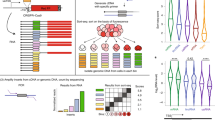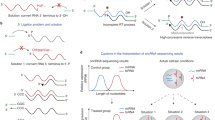Abstract
It has been reported that relatively short RNAs of heterogeneous sizes are derived from sequences near the promoters of eukaryotic genes. As part of the FANTOM4 project, we have identified tiny RNAs with a modal length of 18 nt that map within −60 to +120 nt of transcription start sites (TSSs) in human, chicken and Drosophila. These transcription initiation RNAs (tiRNAs) are derived from sequences on the same strand as the TSS and are preferentially associated with G+C-rich promoters. The 5′ ends of tiRNAs show peak density 10–30 nt downstream of TSSs, indicating that they are processed. tiRNAs are generally, although not exclusively, associated with highly expressed transcripts and sites of RNA polymerase II binding. We suggest that tiRNAs may be a general feature of transcription in metazoa and possibly all eukaryotes.
This is a preview of subscription content, access via your institution
Access options
Subscribe to this journal
Receive 12 print issues and online access
$209.00 per year
only $17.42 per issue
Buy this article
- Purchase on Springer Link
- Instant access to full article PDF
Prices may be subject to local taxes which are calculated during checkout




Similar content being viewed by others
Change history
26 June 2009
NOTE: In the version of this article initially published, some author affiliations were incorrectly stated. The error has been corrected in the HTML and PDF versions of the article.
References
Chu, C.Y. & Rana, T.M. Small RNAs: regulators and guardians of the genome. J. Cell. Physiol. 213, 412–419 (2007).
Mattick, J.S. & Makunin, I.V. Small regulatory RNAs in mammals. Hum. Mol. Genet. 14, R121–R132 (2005).
Davis, C.A. & Ares, M. Jr. Accumulation of unstable promoter-associated transcripts upon loss of the nuclear exosome subunit Rrp6p in Saccharomyces cerevisiae. Proc. Natl. Acad. Sci. USA 103, 3262–3267 (2006).
Chekanova, J.A. et al. Genome-wide high-resolution mapping of exosome substrates reveals hidden features in the Arabidopsis transcriptome. Cell 131, 1340–1353 (2007).
Guenther, M.G., Levine, S.S., Boyer, L.A., Jaenisch, R. & Young, R.A. A chromatin landmark and transcription initiation at most promoters in human cells. Cell 130, 77–88 (2007).
Kapranov, P. et al. RNA maps reveal new RNA classes and a possible function for pervasive transcription. Science 316, 1484–1488 (2007).
Tsuchiya, S. et al. Induction of maturation in cultured human monocytic leukemia cells by a phorbol diester. Cancer Res. 42, 1530–1536 (1982).
Glazov, E.A. et al. A microRNA catalog of the developing chicken embryo identified by a deep sequencing approach. Genome Res. 18, 957–964 (2008).
Ruby, J.G. et al. Evolution, biogenesis, expression, and target predictions of a substantially expanded set of Drosophila microRNAs. Genome Res. 17, 1850–1864 (2007).
Chung, W.J., Okamura, K., Martin, R. & Lai, E.C. Endogenous RNA interference provides a somatic defense against Drosophila transposons. Curr. Biol. 18, 795–802 (2008).
Czech, B. et al. An endogenous small interfering RNA pathway in Drosophila. Nature 453, 798–802 (2008).
Carninci, P. et al. High-efficiency full-length cDNA cloning by biotinylated CAP trapper. Genomics 37, 327–336 (1996).
Shiraki, T. et al. Cap analysis gene expression for high-throughput analysis of transcriptional starting point and identification of promoter usage. Proc. Natl. Acad. Sci. USA 100, 15776–15781 (2003).
Carninci, P. et al. Genome-wide analysis of mammalian promoter architecture and evolution. Nat. Genet. 38, 626–635 (2006).
de Hoon, M. & Hayashizaki, Y. Deep cap analysis gene expression (CAGE): genome-wide identification of promoters, quantification of their expression, and network inference. Biotechniques 44 (Suppl.), 627–632 (2008).
Eis, P.S. et al. Accumulation of miR-155 and BIC RNA in human B cell lymphomas. Proc. Natl. Acad. Sci. USA 102, 3627–3632 (2005).
Pedersen, J.S. et al. Identification and classification of conserved RNA secondary structures in the human genome. PLOS Comput. Biol. 2, e33 (2006).
Siepel, A. et al. Evolutionarily conserved elements in vertebrate, insect, worm, and yeast genomes. Genome Res. 15, 1034–1050 (2005).
Griffiths-Jones, S., Saini, H.K., van Dongen, S. & Enright, A.J. miRBase: tools for microRNA genomics. Nucleic Acids Res. 36, D154–D158 (2008).
Karolchik, D. et al. The UCSC Genome Browser Database: 2008 update. Nucleic Acids Res. 36, D773–D779 (2008).
Kaczynski, J., Cook, T. & Urrutia, R. Sp1- and Kruppel-like transcription factors. Genome Biol. 4, 206 (2003).
Kadonaga, J.T. The DPE, a core promoter element for transcription by RNA polymerase II. Exp. Mol. Med. 34, 259–264 (2002).
Frith, M.C. et al. A code for transcription initiation in mammalian genomes. Genome Res. 18, 1–12 (2008).
Pall, G.S., Codony-Servat, C., Byrne, J., Ritchie, L. & Hamilton, A. Carbodiimide-mediated cross-linking of RNA to nylon membranes improves the detection of siRNA, miRNA and piRNA by northern blot. Nucleic Acids Res. 35, e60 (2007).
Mellor, J., Dudek, P. & Clynes, D. A glimpse into the epigenetic landscape of gene regulation. Curr. Opin. Genet. Dev. 18, 116–122 (2008).
Margaritis, T. & Holstege, F.C. Poised RNA polymerase II gives pause for thought. Cell 133, 581–584 (2008).
Zeitlinger, J. et al. RNA polymerase stalling at developmental control genes in the Drosophila melanogaster embryo. Nat. Genet. 39, 1512–1516 (2007).
Pal, M., McKean, D. & Luse, D.S. Promoter clearance by RNA polymerase II is an extended, multistep process strongly affected by sequence. Mol. Cell. Biol. 21, 5815–5825 (2001).
Wind, M. & Reines, D. Transcription elongation factor SII. Bioessays 22, 327–336 (2000).
Adelman, K. et al. Efficient release from promoter-proximal stall sites requires transcript cleavage factor TFIIS. Mol. Cell 17, 103–112 (2005).
Prather, D.M., Larschan, E. & Winston, F. Evidence that the elongation factor TFIIS plays a role in transcription initiation at GAL1 in Saccharomyces cerevisiae. Mol. Cell. Biol. 25, 2650–2659 (2005).
Weilbaecher, R.G., Awrey, D.E., Edwards, A.M. & Kane, C.M. Intrinsic transcript cleavage in yeast RNA polymerase II elongation complexes. J. Biol. Chem. 278, 24189–24199 (2003).
Zhang, C., Yan, H. & Burton, Z.F. Combinatorial control of human RNA polymerase II (RNAP II) pausing and transcript cleavage by transcription factor IIF, hepatitis delta antigen, and stimulatory factor II. J. Biol. Chem. 278, 50101–50111 (2003).
Tam, O.H. et al. Pseudogene-derived small interfering RNAs regulate gene expression in mouse oocytes. Nature 453, 534–538 (2008).
Meissner, A. et al. Genome-scale DNA methylation maps of pluripotent and differentiated cells. Nature 454, 766–770 (2008).
Janowski, B.A. et al. Inhibiting gene expression at transcription start sites in chromosomal DNA with antigene RNAs. Nat. Chem. Biol. 1, 216–222 (2005).
Janowski, B.A. et al. Involvement of AGO1 and AGO2 in mammalian transcriptional silencing. Nat. Struct. Mol. Biol. 13, 787–792 (2006).
Morris, K.V., Chan, S.W., Jacobsen, S.E. & Looney, D.J. Small interfering RNA-induced transcriptional gene silencing in human cells. Science 305, 1289–1292 (2004).
Ting, A.H., Schuebel, K.E., Herman, J.G. & Baylin, S.B. Short double-stranded RNA induces transcriptional gene silencing in human cancer cells in the absence of DNA methylation. Nat. Genet. 37, 906–910 (2005).
Schwartz, J.C. et al. Antisense transcripts are targets for activating small RNAs. Nat. Struct. Mol. Biol. 15, 842–848 (2008).
Lagonigro, M.S. et al. CTAB-urea method purifies RNA from melanin for cDNA microarray analysis. Pigment Cell Res. 17, 312–315 (2004).
Margulies, M. et al. Genome sequencing in microfabricated high-density picolitre reactors. Nature 437, 376–380 (2005).
Fromont-Racine, M., Bertrand, E., Pictet, R. & Grange, T. A highly sensitive method for mapping the 5′ termini of mRNAs. Nucleic Acids Res. 21, 1683–1684 (1993).
Faulkner, G.J. et al. A rescue strategy for multimapping short sequence tags refines surveys of transcriptional activity by CAGE. Genomics 91, 281–288 (2008).
Arbeitman, M.N. et al. Gene expression during the life cycle of Drosophila melanogaster. Science 297, 2270–2275 (2002).
Castillo-Davis, C.I. & Hartl, D.L. GeneMerge–post-genomic analysis, data mining, and hypothesis testing. Bioinformatics 19, 891–892 (2003).
Tews, B. et al. Hypermethylation and transcriptional downregulation of the CITED4 gene at 1p34.2 in oligodendroglial tumours with allelic losses on 1p and 19q. Oncogene 26, 5010–5016 (2007).
Acknowledgements
We thank A. Hasegawa, F. Hori, H. Sano for technical assistance. R.J.T. is supported by a US National Science Foundation Graduate Research Fellowship. N.C. is supported by a University of Queensland Postdoctoral Research Fellowship. A.R.R.F. is supported by a CJ Martin Fellowship from the Australian National Health and Medical Research Council (ID 428261). S.M.G. is supported by Australian NH&MRC Fellowship grant no. 455857. V.O. is supported by Telethon TCP00094, Associazione Italiana Riecrca sul Cancro (AIRC), Compagnia San Paolo. J.S.M. is supported by an Australian Research Council Federation Fellowship (ID FF0561986), the University of Queensland and the Queensland State Government. This work was also supported by grants for the Genome Network Project from the Ministry of Education, Culture, Sports, Science and Technology, Japan (Y.H.), and Research Grant for the RIKEN Genome Exploration Research Project from the Ministry of Education, Culture, Sports, Science and Technology of the Japanese Government, the RIKEN Frontier Research System, Functional RNA Research Program (Y.H.). We thank the reviewers for their insights and suggestions.
Author information
Authors and Affiliations
Contributions
R.J.T. designed the bioinformatic experiments, led the analysis and wrote the manuscript. E.A.G. assisted with the chicken small RNA deep sequencing datasets analysis and helped to write the manuscript. N.C. performed the analysis of THP-1 gene expression. C.S. and S.S. created an in-house database and mapped THP-1 small RNA sequences. G.J.F. analyzed THP-1 promoter architecture. T.L. organized and analyzed THP-1 small RNA sequences. A.R.R.F. and S.M.G. advised on experimental design. K.S., K.I., T.A., M.N., A.K., K.H., C.K., M.M., H.N., S.F., J.K., C.O.D., D.A.H., H.S., V.O., P.C. and Y.H. generated the THP-1 small RNA, deepCAGE, microarray expression, and ChIP-chip data. P.C. and D.A.H. also helped to write the manuscript. J.S.M. helped to design the study and wrote the manuscript. For further information about the small RNA sequencing, contact V.O. (vorlando@vti.telethon.it) or P.C. (carninci@riken.jp). For further information about the bioinformatic analyses, contact R.J.T. (r.taft@imb.uq.edu.au).
Corresponding authors
Ethics declarations
Competing interests
A patent application based on this work has been made.
Supplementary information
Supplementary Text and Figures
Supplementary Figures 1–12, Supplementary Methods, Supplementary Tables 1 and 2 (PDF 4858 kb)
Rights and permissions
About this article
Cite this article
Taft, R., Glazov, E., Cloonan, N. et al. Tiny RNAs associated with transcription start sites in animals. Nat Genet 41, 572–578 (2009). https://doi.org/10.1038/ng.312
Received:
Accepted:
Published:
Issue Date:
DOI: https://doi.org/10.1038/ng.312
This article is cited by
-
Vault RNAs: hidden gems in RNA and protein regulation
Cellular and Molecular Life Sciences (2021)
-
Principles and innovative technologies for decrypting noncoding RNAs: from discovery and functional prediction to clinical application
Journal of Hematology & Oncology (2020)
-
MicroRNAs (miRNAs) and Long Non-Coding RNAs (lncRNAs) as New Tools for Cancer Therapy: First Steps from Bench to Bedside
Targeted Oncology (2020)
-
Association of microRNAs with Argonaute proteins in the malaria mosquito Anopheles gambiae after blood ingestion
Scientific Reports (2017)
-
The MicroRNA Biology of the Mammalian Nucleus
Molecular Therapy - Nucleic Acids (2014)



